|
Heavenly Violet-Blue Weekend
The American Violet Society's
Spring 2001 Eastern USA, Field Event
"Uncovering Violet Treasures" In The Dunbar Hills
Saturday, April 21, 2001
|
© 2001 The American Violet Society All Rights Reserved |
|
|
|
|
|
|
By Elizabeth Scott
Photos By Gary W. Sherwin |
|
| |
| |
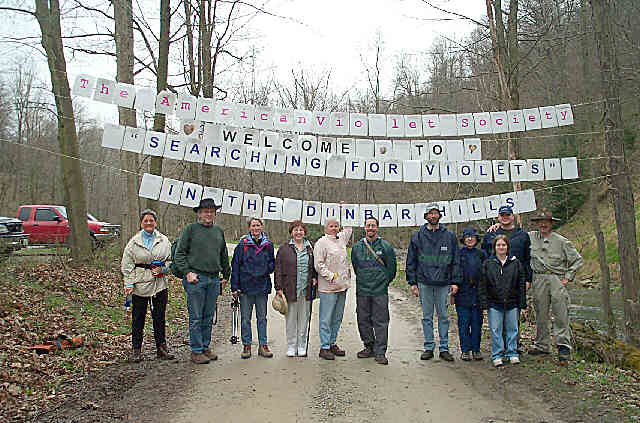 |
Vicki
Johnson, Chris Blaxland, Kim Blaxland,
Norma Beredjiklian, Annebelle
Rice,
Harvey Ballard,
Andrew Stuart, Elizabeth Scott, Lisa Beranek,
Stephen Sherwin, Gary
Sherwin |
|
|
| |
|
The
long-anticipated American Violet Society field trip of April 21, 2001, has come
and gone, and what a wonderful day it was! Early Saturday morning, Gary met us
at our respective hotels in Uniontown, Pennsylvania. Our first stop was
breakfast at Pechin Shopping Village, which has the largest volume of
business of any market in the world. More impressive than that, its coffee is 10
cents a cup. 10 cents a cup, now that itself is worth a trip! In addition to the
group of violet lovers, which included the violet authorities Harvey Ballard,
Jr. of Ohio University in Athens, Ohio, and Kim Blaxland, there was a
reporter and a photographer who were doing a story on our outing for the
Pittsburgh Sunday Tribune. They were impressed by our dedication and enjoyed the
trip as much as we did.
|
| |
| |
| Looking back on what the AVS accomplished on this violet exploration day reminds me of Sarah Ban Breathnach's words:
"The world needs dreamers and the world needs doers.
But above all, the world needs dreamers who do.".
Norma Beredjiklian |
|
|
| |
| |
| |
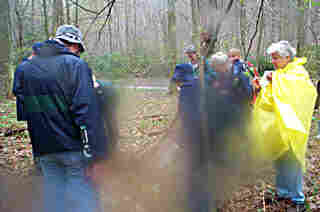 |
| Looking
at Violets |
|
|
| |
|
After breakfast, we set out for Dunbar Creek. We turned off onto
a dirt road along the creek and soon came to banners across the road
reading "The American Violet Society, Welcome to 'Searching for
Violets' in the Dunbar Hills". It was raining a little, but that
didn't dampen our spirits. First we walked back down the road to see
flowers we had passed in the car and then along the creek, progressing
very slowly because we stopped every few feet to admire the flowers.
Photographers had many opportunities for great shots (and photographers
themselves were wonderful subjects for photos as they lay flat in the
mud trying to get those great shots).
|
| |
| |
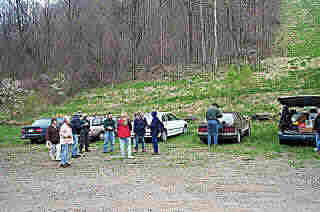 |
| We're
Here! |
|
|
| |
| |
| |
 |
| At
Work |
|
|
| |
|
| |
| |
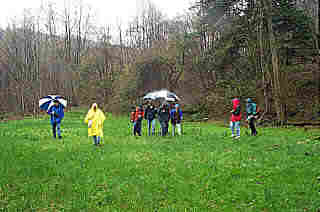 |
| The
Meadow |
|
|
| |
| |
| |
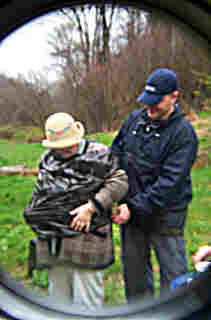 |
Norma's
Garbage-bag
raincoat |
|
|
| |
|
Our path eventually led us to a
meadow where we would have had lunch had it not been raining, a meadow
covered with violets (V. sororia). Even in the rain it was
beautiful, but it would have been a blue paradise if there had been some
sunshine to bring out the flowers. We had to cross the creek to get
there, and Gary had spent hours on Friday putting stones in for us to
step across on. We did not believe we could do it, but we did, and not a
single one of us fell in
| |
| |
| Gary, Thanks for a wonderful, well organized and
thoroughly enjoyable (for the rest of us :>)) trip to
Dunbar Hills. It's an outstanding area for violets, and
you made the expedition a success with your knowledge,
your thoughtfulness, and your great kindness. We're all
indebted to you..
Harvey Ballard |
|
|
| |
|
| |
| |
 |
| We
Cross Here |
|
|
| |
| |
| |
 |
| Talking
About Things |
|
|
| |
|
|
Along the way we
saw hundreds of common blue violets, V. sororia, and a lot of
the stemmed yellow violet, V.
pubescens. Viola rotundifolia is the first violet of the
year to bloom, and because the spring had been so cool there were
still some little yellow blooms left. We also saw halberd-leaved
violet, V.
hastata, perhaps our most beautiful native violet, with its yellow
flowers and pointed, silver-patterned leaves, and a lot of that
little white beauty, Viola blanda. I sniffed many of the V. blanda
blooms but couldn't detect any fragrance, although sometimes they
are scented. A real treat was Viola rostrata, the purple
long-spurred violet, which is so easy to recognize because of that
spur.
|
| |
| |
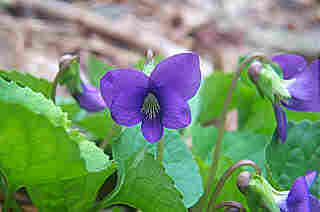 |
| Viola
sororia |
|
|
| |
|
| |
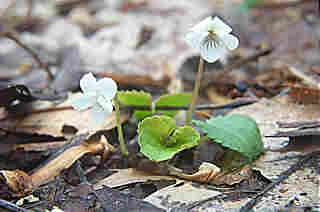 |
| Viola
blanda |
|
| |
|
| |
| |
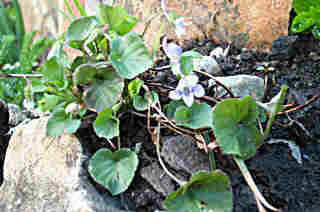 |
| Viola
rostrata |
|
|
| |
|
| |
| |
 |
| Viola
pubescens |
|
| |
|
| |
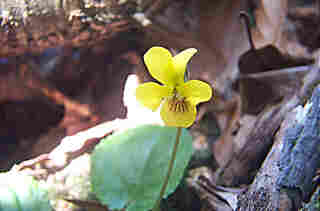 |
| Viola
rotundifolia |
|
| |
|
| |
| |
 |
| Viola
hastata |
|
|
| |
|
| |
| |
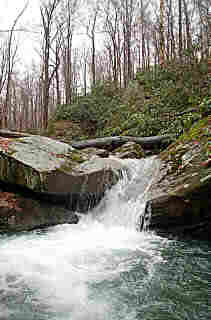 |
| Falling
Water |
|
|
| |
|
Along
the way we met a Native American in full traditional dress coming out of the
woods. He was wearing a hand-made porcupine quill head-dress and carried a
ceremonial deer-hoof rattle. He said he was from the Delaware tribe and
told us about the different tribes that had inhabited the area. He had collected
some plants, including violets, that he said were used medicinally by the
Indians. This interesting scenario was enacted by Zack Ware, one of
Gary's Eagle Scouts who is chairman of the ceremonial and dance team of an honor
scouting organization which has as one of its goals, the study and preservation
of the Native American heritage. He seemed a little nervous, but any lone
Native, meeting a group of European invaders would be.
|
| |
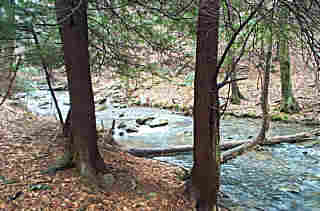 |
| Along
The Stream |
|
| |
| |
| |
| Wasn't it a wonderful day! Gary's organization was
superb. We found the general background of history and
local ecology to be as fascinating as the violets. It is
people like Gary who make this country so great.
Kim Blaxland |
|
|
| |
|
|
Since we could not eat lunch on the violet meadow, we returned to the
cars and had a tailgate lunch that Gary's sons Matthew and Stephen
and Stephen's friend Lisa had prepared and set up for us. There
were different breads and crackers, meats and cheeses and spreads (even
a Violet spread!), and Gary's favorite wild cress as a garnish. There
was a large kettle of steaming, home-made soup that was most welcome
since we were all so wet, and coffee and hot water for tea, even mint
leaves from Gary's garden for tea. I have never before had such an
elegant lunch on a field trip, and the rain had stopped by that time so
our sandwiches did not get soggy while we ate them.
After lunch we went to an area of higher elevation and added two more
violet species. I have already said that Viola hastata is our
most beautiful violet, but we saw V. hirsutula, and I changed my
mind when I saw that one and will assure you that it is our most
beautiful violet. It is the southern wood violet with purple flowers and
leaves that look silver on the upper surface because they are covered
with white hairs and are purplish underneath. It doesn't occur in
masses, but once you have seen it, you can walk along and spot it among
the surrounding V. sororia plants because of those beautiful
silvery leaves.
|
|
The other violet we saw in this hilly, rocky area was a V.
sagittata that engendered much discussion because several former
species of stemless blue violets are now aggregated under the name V.
sagittata. Those species were difficult to differentiate because
they varied so much, having some characteristics of one so-called
species and some of another, so they are now considered to be variations
of just one species with the name V. sagittata. The violet we saw
was most like what used to be called V. fimbriatula, with hairy
leaves flat against the ground and just beginning to have lobes at the
bottom, growing in exposed, rocky places rather than in moist woodlands
like most violets. Harvey Ballard now calls this V. sagittata var.
ovata.
|
| |
| |
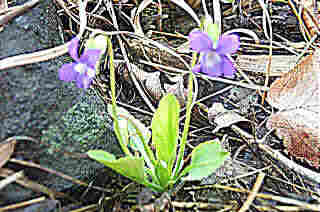 |
| Viola
sagittata -f- ovata |
|
|
| |
|
| |
| |
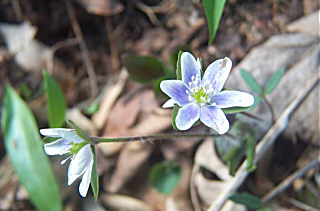 |
Hepatica
nobilis -f- acuta
(Acute Lobed Hepatica) |
|
|
| |
|
Of course
we saw many flowers other than violets and because of the cool
weather there were even a few blossoms left of the early blooming
hepatica and bloodroot. The hillsides were covered with trillium,
mostly
T. grandiflorum, but also wake-robin, the dark red Trillium
erectum. We found wild ginger (Asarum canadense), wood
anemone (Anemone quinquefolia), two toothworts (Dentaria
diphylla and D. laciniata), Dutchman's breeches and squirrel
corn (Dicentra cucullaria and D. canadensis),
bishop's hat or mitrewort (Mitella diphylla), the lovely
blue Jacob's ladder (Polemonium
reptans), the nodding Perfoliated bellwort (Uvularia perfoliata) and
many other flowers and ferns. The woodland edges were so beautiful
with redbud in full bloom everywhere and dogwood just beginning to
open.
|
| |
| |
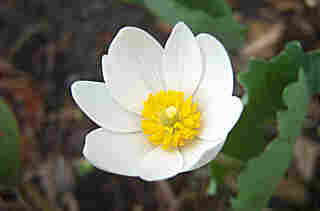 |
Sanguinaria
canadensis
(Bloodroot) |
|
|
| |
|
| |
 |
| Trillium
grandiflorum |
|
| |
|
| |
| |
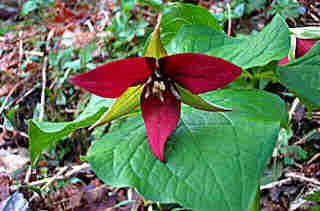 |
Trillium
erectum
(Wake Robin) |
|
|
| |
|
| |
| |
 |
Asarum
canadense
(Wild Ginger) |
|
|
| |
|
| |
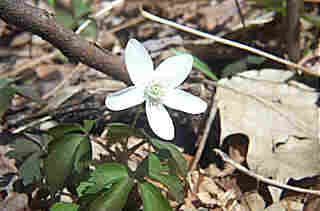 |
Anemone
quinquefolia
(Wood Anemone) |
|
| |
|
| |
| |
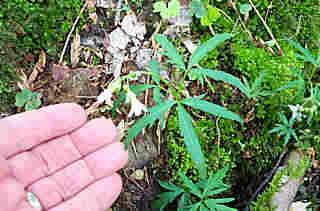 |
Dentaria
lacinata
(Cut-leaved Toothwort) |
|
|
| |
|
| |
| |
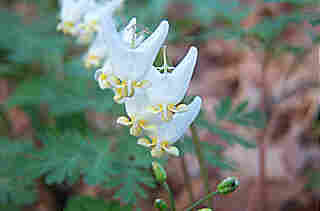 |
Dicentra
cucularia
(Dutchman's Breeches) |
|
|
| |
|
| |
| |
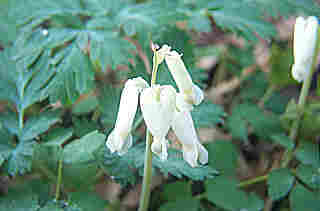 |
Dicentra
canadensis
(Squirrel Corn) |
|
|
| |
|
| |
| |
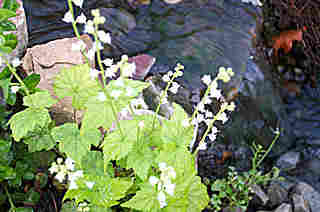 |
Mitella
diphylla
(Miterwort / Bishop's Cap) |
|
|
| |
|
| |
| |
 |
Uvularia
perfoliata
(Perfoliated Bellwort) |
|
|
| |
|
| |
 |
Callophyllum
thalictroides
(Blue Cohosh) |
|
| |
|
| |
| |
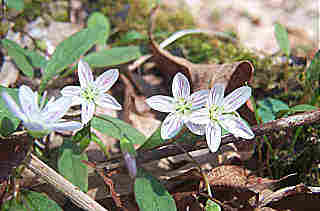 |
Claytonica
virginica
(Spring Beauties) |
|
|
| |
|
| |
| |
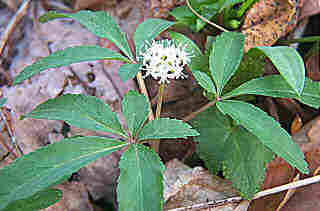 |
Panax
Trifolia
(Dwarf Ginseng) |
|
|
| |
|
| |
 |
Acorus
calamus
(Sweet-flag) |
|
| |
|
| |
| |
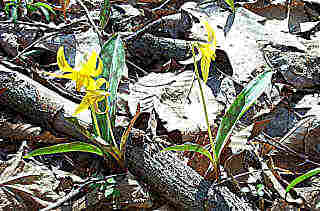 |
Erythronium
americanum
(Trout Lilly) |
|
|
| |
|
|
|
|
|
|
|
|
|
|
We
were very tired and muddy by the end of the afternoon, but we had
enough time to appear for dinner rested and clean. We had dinner
at the historic Stone House built in 1822, which also had a sign
welcoming the American Violet Society. I chose the trout from
among the many entrees because Dunbar Creek is a noted trout
stream and we had seen fishermen all along the stream. After
dinner Harvey talked to us about distinguishing the varieties of V. sagittata.
Then we looked at some of Gary's violet pictures and a selection
of Kim's wonderful slides. We saw the variation in leaf form of Viola douglasii
in different locations and some violets from her trips to Utah,
not a place one would usually associate with violets. One of these
was Viola
frank-smithii, a violet recently discovered by Frank Smith on a
cliff face in Utah. There were also photos of Peppered Palms, a
cross between V. sororia 'Freckles' and V. palmata,
and of some other improbable hybrids that she has seen. And each
of us received from Gary a viola to take home as a memento of our
day.
It was a truly wonderful day, meeting other violet lovers we had known
only from the Internet, seeing beautiful Dunbar Creek and finding and
identifying together so many lovely violets. The privilege of doing that
in the company of the violet authorities Harvey Ballard and Kim Blaxland
was a priceless experience. Gary's generosity in planning and carrying
through all this for us was extraordinary. Altogether it was an awesome
day!
We
briefly discussed an American Violet Society trip for next spring. You will be
amply rewarded for attending in 2002. If you have comments or suggestions about
such a trip, please let us know.
|
| |
| |
| I know that people think it is amazing (or nuts) to travel clear across the country to look at violets for one day. But as I told Gary, it was worth more than the
airfare!
To meet people who share my passion for violets, to see the sweet little flower growing profusely in the wild, and to gain knowledge which enhances my life are part of the violet experience. I was especially thrilled to meet those with whom I have had only email
contact.
Can't wait for the next trek..
Annebelle Rice |
|
|
| |
| |
| |
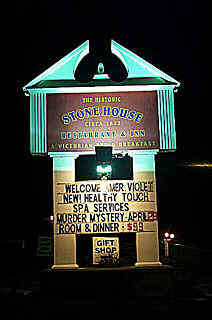 |
| Welcome
AVS |
|
|
| |
|
| |
| |
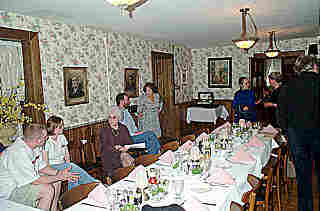 |
| Gathering
For Dinner |
|
|
| |
|
| |
| |
 |
| Around
The Table |
|
|
| |
|
| |
| |
 |
| After
Dinner Seminar |
|
|
| |
|
|
|
|
| I want to thank everyone who helped make The
American Violet Society's Spring 2001 Eastern US Field Event, "Searching
For Violets" In The Dunbar Hills such a
success. I would have to say that being part of this
event, was one of the greatest times I have had sharing our
natural world with other people. The support, attention,
cooperation and enthusiasm that each of you showed me was
wonderful. I would love to do it again, perhaps a little
later in the spring, so as to see a different selection of
flowers. I sincerely hope that this event establishes a
standard, following our tradition of "Quality in
Quantity". Now, I am looking forward to our next
field event. I certainly hope I will be able to
attend. May God bless each of you as you all have
blessed me.
Sincerely.
Gary W. Sherwin |
|
|
|
|
|
|
|